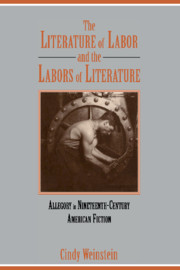 The Literature of Labor and the Labors of Literature
The Literature of Labor and the Labors of Literature Book contents
- Frontmatter
- Contents
- Acknowledgments
- Introduction
- 1 The Problem with Labor and the Promise of Leisure
- 2 Hawthorne and the Economics of Allegory
- 3 Melville's Operatives
- 4 Twain in the Man-factory
- 5 The Manikin, the Machine, and the Virgin Mary
- Afterword
- Notes
- Index
- CAMBRIDGE STUDIES IN AMERICAN LITERATURE AND CULTURE
5 - The Manikin, the Machine, and the Virgin Mary
Published online by Cambridge University Press: 06 July 2010
- Frontmatter
- Contents
- Acknowledgments
- Introduction
- 1 The Problem with Labor and the Promise of Leisure
- 2 Hawthorne and the Economics of Allegory
- 3 Melville's Operatives
- 4 Twain in the Man-factory
- 5 The Manikin, the Machine, and the Virgin Mary
- Afterword
- Notes
- Index
- CAMBRIDGE STUDIES IN AMERICAN LITERATURE AND CULTURE
Summary
The burden of individualized, interiorized characters is abandoned in The Mysterious Stranger, #44 as Twain discovers a kind of liberation from the constraints of efficiency in the construction of duplicated characters. To be sure, the manikin in the preface to The Education of Henry Adams looks extremely familiar after our discussion of duplicates and #44. Such characters participate in a strikingly different narrative of American identity, a narrative of allegorical personhood as opposed to the customary symbolic one. They have an unconventional, to say the least, relation to nature, interiority, and individuality, and their mere presence issues a perilous warning to all traditional notions of coherent and organic identity. Nevertheless, how each of them comes to subvert conventional configurations of personhood is slightly different. For example, the unraveling of identity brought about by the indistinguishability of duplicates and originals in The Mysterious Stranger, #44 does not exist in the Education, because there are no originals with which/whom duplicates can be confused in Adams's world. There are only manikins. The confusion of a manikin, furthermore, has less to do with its relation to an original identity, as was the case with Twain, and more to do with its relation to the proliferating number of fictional identities it may inhabit. Will it wear the clothes of a banker or a mechanic? Will it occupy the shop window of Macy's or a less expensive imitation? And how successful will it be at selling the products it dons? But for all of the differences between Twain's duplicates and Adams's manikin - and we shall get to them - these unlikely fictional characters, these allegorical characters, primarily exist in relation to the discourse of work.
- Type
- Chapter
- Information
- The Literature of Labor and the Labors of LiteratureAllegory in Nineteenth-Century American Fiction, pp. 173 - 206Publisher: Cambridge University PressPrint publication year: 1995
